Newsletter: East Palestine Train Derailment Response, 11-1-2023
Expanded Edition
Newsletter serving East Palestine, Negley, Darlington, and surrounding communities
- Progress Made
- The Look Ahead
- Site Status Check
- Community Corner
- Top 3 Questions of the Week
- New Hours
- Response Timeline
- The Three Orders
- Groundwater Monitoring
- Ongoing Recovery
- Community Workshops and Research
- Stay Informed
- About this Publication
Progress Made

EPA Issues Administrative Order
On October 18, EPA ordered Norfolk Southern to conduct additional cleanup and investigation focused on oily sheens and sediments in Sulphur Run and Leslie Run creeks in East Palestine and surrounding areas. This order under EPA’s Clean Water Act authority will build on the assessment and cleanup work already conducted in the creeks over the last several months and is a progression of response actions at the site based on data collected and analyzed. Work done under this order will determine if more cleanup is necessary to ensure any potential long-term impacts are addressed.
Car Scrapping Area 4 and South Ditch Excavations are Complete

Excavation of two major contaminated areas on the south side of the train tracks, known as Car Scrapping Area 4 and South Ditch, are complete. Sampling showed excavation removed contamination in these areas. The next step is to backfill with clean soil and ballast. Site restoration will be coordinated with the property owners. Crews will continue confirmatory sampling as part of final site evaluation to ensure no hazards remain.
Air Monitoring Update
Over the next few weeks, community members will see changes in the air monitoring and sampling equipment in the area. Now that the major excavation of hazardous materials is complete, air monitoring and sampling will no longer be required around the perimeter of the site and devices will be removed from utility poles and other locations. This includes the PTR-MS (Proton Transfer Reaction –
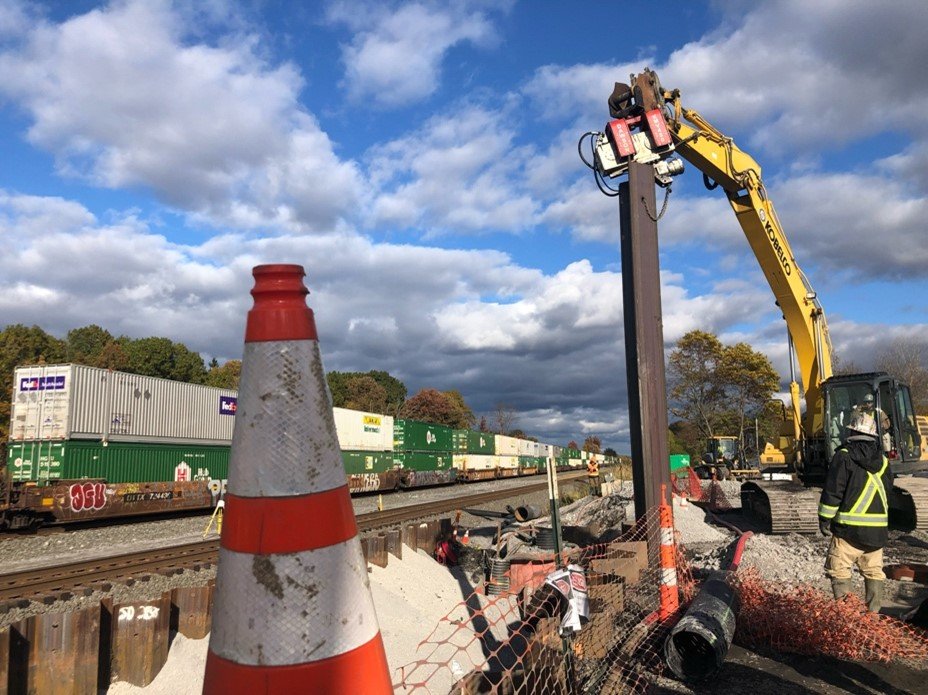
Mass Spectrometry) air monitoring vans. Moving forward, precautionary air monitoring and sampling may be conducted on a task-specific basis. In those cases, community members may see monitoring and sampling equipment in other locations when work is being conducted.
Confirmatory Soil Sampling in East Palestine Park Continues
Although areas at and near East Palestine Park are being assessed, there has been no evidence of contamination in that area, other than known contamination in creek sediments. A previous assessment of East Palestine Park conducted in March did not show any contamination above background levels for derailment-related chemicals.
The Look Ahead
At the Derailment Site
- On-site excavation work is complete and stockpiled contaminated soil is being removed from the staging areas. Confirmation soil sampling continues in areas at and near the derailment site.
- Sampling results from the on-site wastewater treatment system continue to show treated wastewater can be disposed of off-site as non-hazardous. Each tank of treated wastewater is sampled before being shipped off-site.
In the Greater Community
Creek Clean-Up
- Stationary and mobile air monitoring will continue through the end of the week around the community and within the derailment site to monitor post-removal air quality conditions. Air monitoring will then continue on a task specific basis.
- Surface water sampling and visual inspections continue in Sulphur and Leslie Runs.
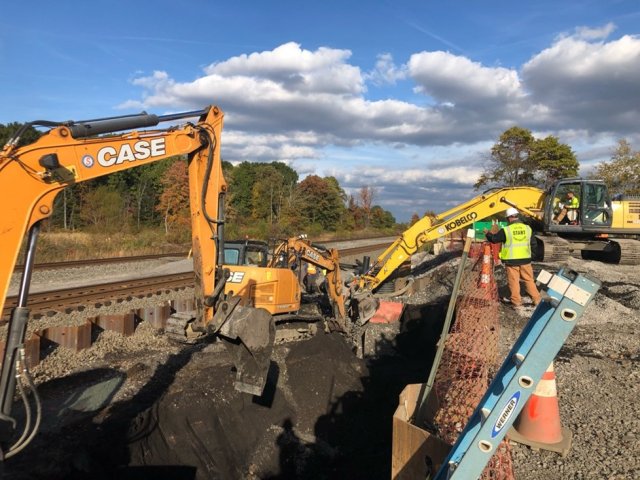
Community Corner

Ohio EPA Water Quality Supervisor Bill Zawiski hosted a two-part series of stream workshops with community members to share more details about Sulphur and Leslie Runs. These “Stream Ambassadors” spent an evening seeing a thorough demonstration of surface water and sediment sampling techniques and learning how that information informs scientists about stream health. The second session focused on biological and ecological sampling with demonstrations including electrofishing, kick net sampling for macroinvertebrates, and habitat evaluation using Ohio’s Qualitative Habitat Evaluation Index, or QHEI.
Did you know?

Sheen, or a shiny film on the water surface, can be caused by biological activity from bacteria in the water. While EPA has observed both biological and chemical sheens in Sulphur and Leslie Runs, it can helpful to know how to tell the difference. Biological sheen can look very similar to sheen caused by petroleum products, but there is a simple way to tell the difference. When a stick is poked into a bacterial sheen or a stone is dropped into it, the sheen will break up into small pieces or plates. In contrast, a petroleum sheen will swirl and reform after a disturbance. Please remember, it is still advised for residents to stay out of Leslie and Sulphur Runs while investigations and cleanup work continue.
Top 3 Questions of the Week
Detrailment Response Timeline
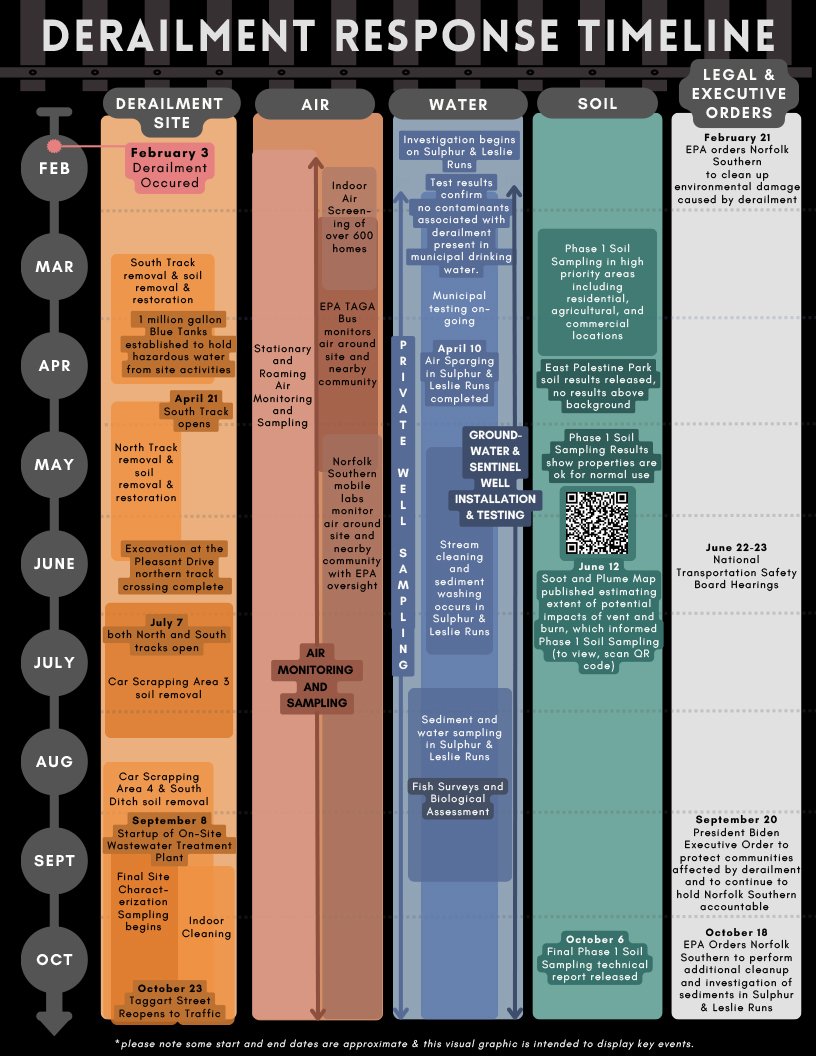
The Three Orders
Long Term Monitoring of Groundwater
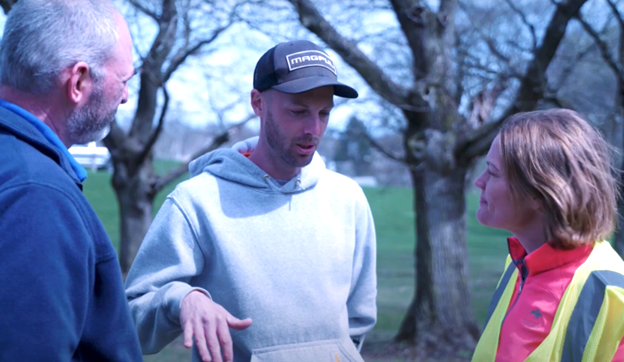
Municipal drinking water, private drinking water wells, and groundwater under and around the derailment site at many locations continue to be monitored and sampled. To date, no contaminants directly related to the derailment have been detected in finished drinking water. Monitoring of drinking water and groundwater sources will continue, to provide assurance to the community that its drinking water remains free of derailment-related contaminants.
Ongoing Recovery
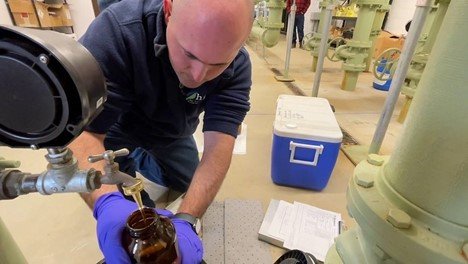
Now that the major excavation of hazardous material is complete, the Unified Command has been reflecting on the past 9 months since the incident occurred. The progress has been remarkable, and we thank our community partners for their support, resilience, and patience
with the process. Although the cleanup seems to have taken a long time, it is important to do the job right and include key community and organizational stakeholders in the process. As Mayor Conaway said in his statement on October 26, we are at a “bittersweet” moment, stating that “We didn’t want these events to happen at all, but they did. It feels good in a sense and sad in a sense that this happened to our village in the first place.”
On October 26, Ohio EPA Director Anne Vogel offered a reassuring statement to the community: “Even after U.S. EPA leaves the site, Ohio EPA, as I am fond of saying, we live here. We’re Ohio. We’re not going anywhere… There are many layers of protection to ensure the residents are safe… We will continue testing those [monitoring wells and sentinel wells] for decades. That is what Ohio EPA does.”
Community Workshop and Research Opportunities
Workshop
The National Academies of Science, Engineering, and Medicine is organizing a virtual public workshop on November 6 to 7 to explore potential health research and surveillance priorities arising from the train derailment. Register for the event and find out more information.
Support Group
The East Palestine Resiliency Project is hosting a Stress Management Support Group from 6 to 7:30 p.m. on the second and fourth Monday of every month at the East Palestine Memorial Public Library on 309 N. Market St. This month’s sessions are scheduled for November 13 and 27. These meetings are offered free of charge to residents of East Palestine and the surrounding communities impacted by the train derailment. For more information, call 330-718-8260.
Voluntary Studies
A group of communication researchers with Carnegie Mellon University are looking for participants over the age of 18 to take part in a voluntary study looking to understand how residents of East Palestine have been receiving information and communicating about the risk posed by the train derailment and chemical release. If you are interested or want more information, please contact Dr. Barbara George or Dr. Lisa Phillips at [email protected] or Dr. Mary Le Rouge at 216-212-5131.
University of Kentucky College of Public Health researcher Dr. Erin N. Haynes and her team received a grant from the National Institutes of Health (NIH) to conduct a long-term health study with and for the residents of East Palestine and the surrounding area. The first step is to learn more about the experiences, health symptoms, and environmental health concerns from residents in the impacted area of the train derailment. Anyone 18 or older who lives in Columbiana, Mahoning, Stark, Carroll, or Jefferson Counties in Ohio and residents of Beaver and Lawrence Counties in Pennsylvania and Hancock County in West Virginia are eligible to participate in the brief online survey. The survey asks questions about experiences during the evacuation, and concerns about exposures and symptoms, including stress. uknow.uky.edu/research/uk-researcher-launching-health-tracking-survey-east-palestine




Public Health Resources
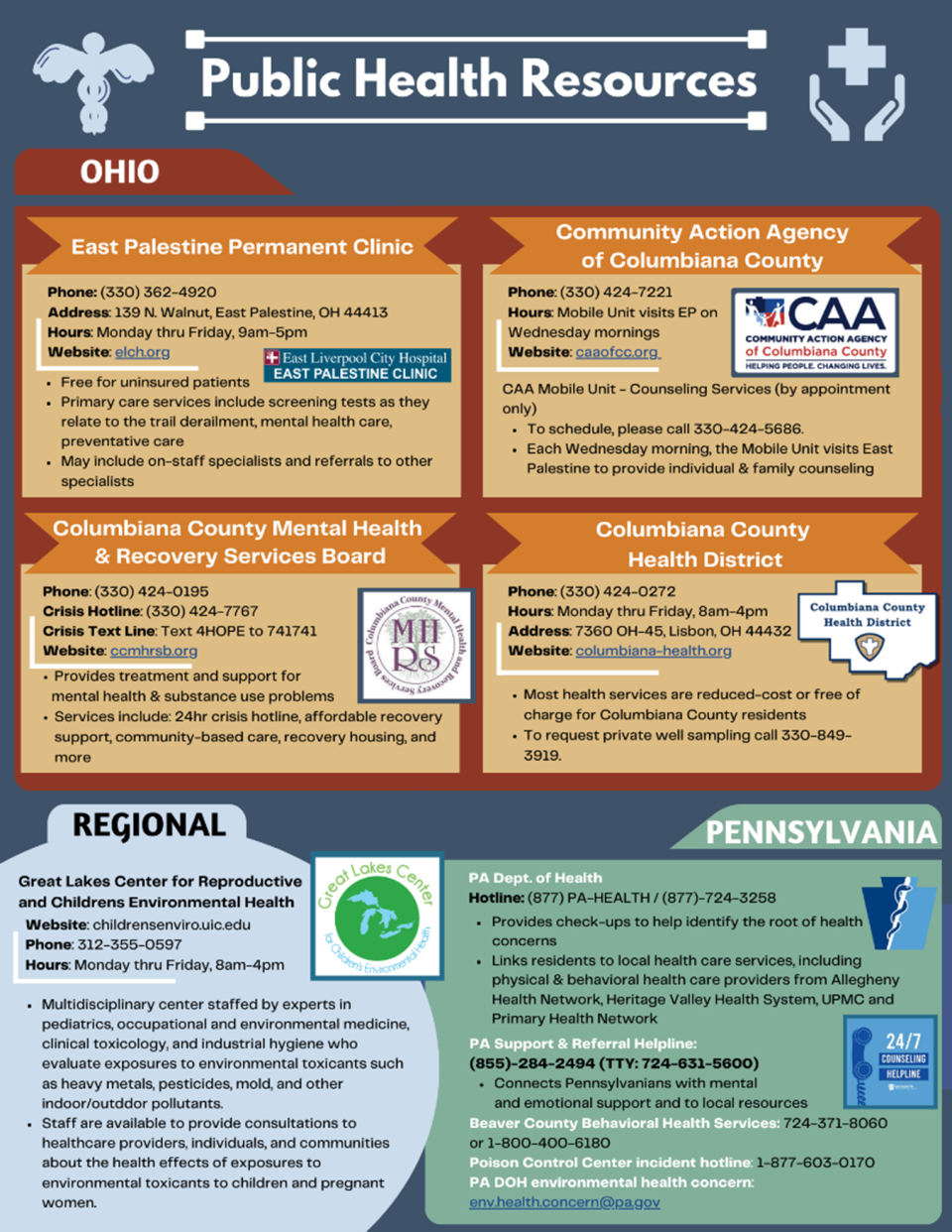
Stay Informed
As major excavation ends at the derailment site, “This Week at E.P.” videos will shift to periodic updates as needed.
Distribution Update
These newsletters will be changing from bi-weekly to monthly starting in November. Mailings will also shift to Wednesday. Expect to receive the upcoming editions on November 15 and December 13.





